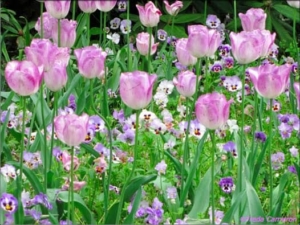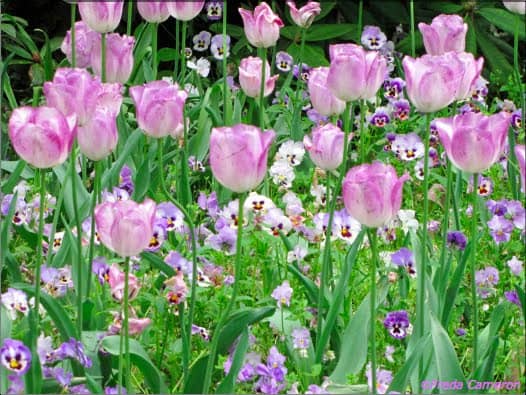Tulips and Pansies
Wildflower Seeds
By Sandy Swegel
Bulbs are a favorite of mine because their beauty is so intense in the garden. But bulbs can be made even more striking by planting them with beautiful pansies or violas. Tulips and Pansies, I think of them as beauty now and later… with little pansy plants bringing color all Fall amid fallen leaves, beauty all winter as at least a few pansies will continue to stick their heads through the snow to shine in the winter sun. And then there is the spectacular beauty of the Spring display as bulbs bloom over a Spring carpet of pansies.
The simple way to plant this orchestra of tulips and pansies or bulbs and pansies is to pick a single color of tulip bulb and a single color of matching pansy or viola. My favorite is yellow tulips (or daffodils) over a sea of azure blue violas. White tulips over deep red pansies invoke a small gasp in passersby. Lavender tulips over white pansies create an elegance reminiscent of old Europe.
It’s very easy to make these little vignettes, even if you only have a tiny corner of your garden available. At it’s tiniest, you can take a two-foot square area of your garden and dig a hole in the center and plant seven tall tulips in a circle. Fill the soil in and plant 12 or so pansies in a grid above and about a foot beyond the centered tulips. For less than $15 you will have a tiny explosion of beauty in your little area. Or both tulips and pansies can be planted together in a container that is overwintered in a protected (but still cold) spot.
If you have a bigger garden and a bigger budget, planting equidistant (spread the tulips out about evenly) over a larger area and plant the violas or pansies in an even grid over the same area so that they grow into a mat by Spring. Then let some of the Fall leaves lay over the pansies creating little warm moist micro-climates that will bloom well into late Fall and even sporadically if there’s snow in the winter.
Enjoy! And take pictures. And back them up twice. I recently lost thousands of pictures including the tulips and pansies I loved because the backup hard drive failed…and I didn’t have hard copies. Alas, the digital world is as ephemeral as tulips under a hot sun.

Photo Credits:
http://definingyourhome.blogspot.com/2010/02/pastel-palette-of-monets-garden.html


